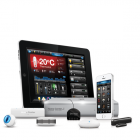You have no items in your shopping cart.
Using Fibaro Dimmers with LED Lights
IMPORTANT - Read this first!
This guide relates to the ORIGINAL Fibaro Universal Dimmer.
Do NOT follow this guide if you are installing the Fibaro Universal Dimmer 2.
You can cause damage to the device, your lighting circuit and your lights if you ignore this warning!
Using LEDs in homes, especially smart homes, is becoming increasingly popular as they use as little as 10% of the energy of a conventional incandescent or halogen bulb. But they do behave differently to conventional bulbs and in many cases you need to tweak the parameter settings of the Z-Wave Dimmer.
This application note shows how to use a Fibaro Dimmer module with LED lighting in a Home Automation installation.
LED Lighting
LED bulbs are very different to the conventional bulbs they're replacing. Conventional bulbs are based on a simple 'filament' wire that glows white hot as the electrical current passes through it. If you vary the voltage and current applied to the bulb you can directly change its brightness.
LED bulbs are more complex, they include electronic circuitry to control them and enable them to work in domestic mains (230V) electrical systems. It's this complexity that allows them to achieve such great power saving efficiency but also what makes them more difficult to use with dimmers of any type.
Many dimmers cannot be used to control LEDs (even if the LEDs are dimmable), so you need to choose a 'Universal Dimmer' such as the Fibaro Universal 500W Dimmer module that is designed to work with a variety of lighting sources including LEDs.
Using Fibaro Dimmers with LEDs
Even though the Fibaro Dimmers are designed to work with LEDs, there are three important points to observe; the dimmer's minimum load, its maximum load and its configuration to work with LEDs.
Minimum Load
The Fibaro Dimmer has a minimum load of 25W. This means that your lighting circuit connected to the dimmer must be more than 25W. This is easy to calculate by adding-up the power (W) of all the bulbs you have on the circuit, if it's more than 25W you should have no problem. If it's less than 25W then we recommend installing a Fibaro Dimmer Bypass.

Figure 1: Installing the Fibaro Dimmer Bypass
The Fibaro Dimmer Bypass acts as a 'dummy' load in the lighting circuit and will help prevent the LEDs flickering at startup, low dim settings or when they should be Off. The dimmer bypass should be installed in one of the light fittings or in the wiring going to the light fitting (Figure 1), it must be connected between the light's Live and Neutral wires. You only need one Dimmer Bypass for each circuit (not for each light bulb).
Maximum Load
The way in which LEDs work can result in very high in-rush currents when they are controlled by a leading-edge dimmer (such as the Fibaro). It is common practise to de-rate the maximum power rating of the dimmer when using LEDs by a factor of 5x - 10x.
We recommend that you limit the LED load for a Fibaro Dimmer to no more than 80W total.
Fibaro Configuration Settings
LED bulbs from different vendors have different characteristics. These variations mean that they can misbehave when used with a dimmer - usually this means they flash at start-up or will not completely turn off.
The Fibaro Dimmer includes a configuration parameter (20) that adjusts the impulse length applied to the bulbs. This parameter can be set to any value between 110 and 170, however we've found that it should be set between 134 and 140 for LEDs to work well. The setting that works best for your LEDs can be found by setting the parameter and testing the lights to see which gives the best (no flicker) results.
Fibaro Dimmer Parameter Setting:Fibaro Dimmer Parameter settings to work with LEDs:
|
For more information about setting the Fibaro Dimmer's configuration parameters, take a look at the 'Related Information' Section below.
Note: In extreme cases, where the LEDs continue to flicker even though the parameters have been correctly set and the load is more than 25W, we recommend fitting the Fibaro Dimmer Bypass.













